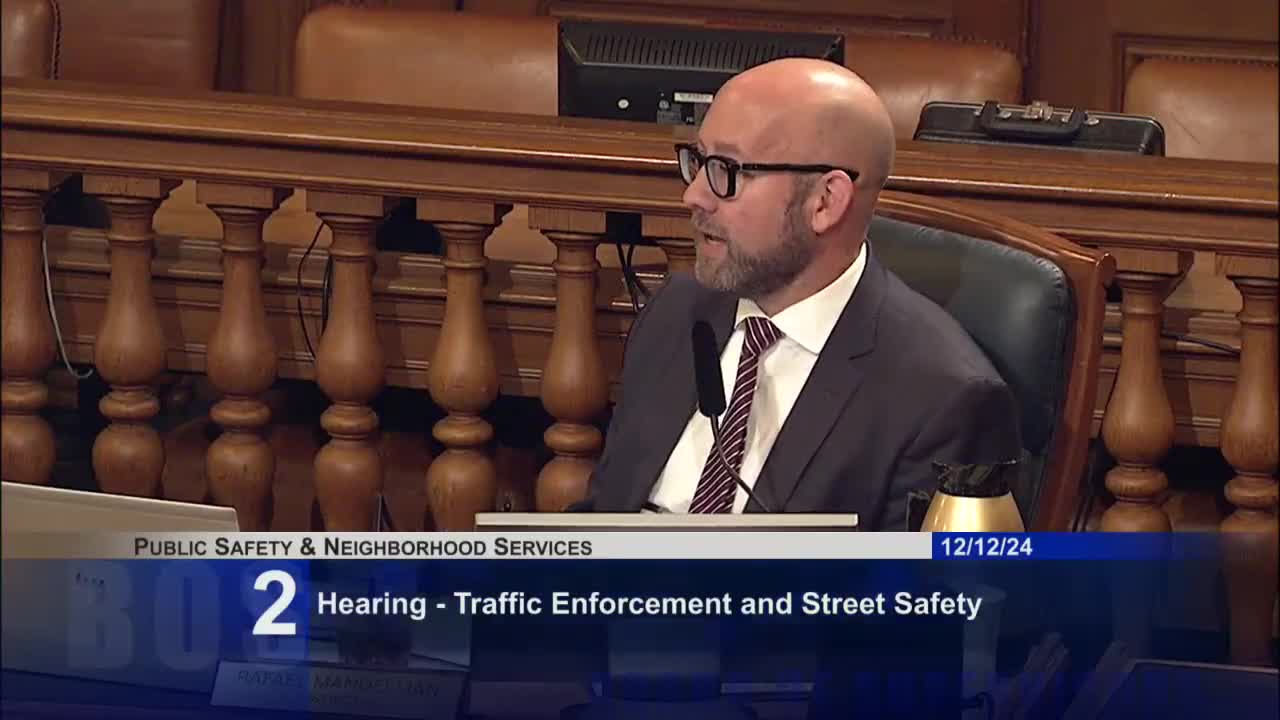SFPD Commander Jones presents revised 2025 traffic enforcement strategies amid rising fatality concerns
December 12, 2024 | San Francisco County, California
This article was created by AI summarizing key points discussed. AI makes mistakes, so for full details and context, please refer to the video of the full meeting. Please report any errors so we can fix them. Report an error »

In the heart of San Francisco's bustling city hall, a pivotal discussion unfolded as city officials gathered to address the pressing issue of traffic safety and enforcement. The meeting, held on July 4, 2025, highlighted the ongoing challenges and strategies of the San Francisco Police Department (SFPD) in managing traffic violations and ensuring public safety on the streets.
Commander Jones of the SFPD's traffic company presented a comprehensive overview of the department's enforcement efforts over the past year. Notably, the number of traffic citations issued has surged, with preliminary figures indicating nearly 13,000 citations by November 2024, a significant increase from just over 5,000 in all of 2023. This upward trend reflects the implementation of a targeted traffic enforcement plan, which aims to enhance safety and reduce violations.
However, the meeting also revealed a stark reality: traffic fatalities have reached alarming levels, with 42 deaths reported in 2024, making it potentially the deadliest year in a decade. The majority of these fatalities involved pedestrians, underscoring the urgent need for improved safety measures. Commander Jones emphasized the importance of collaboration with the Department of Public Health (DPH) to analyze these statistics and refine enforcement strategies.
Despite the progress in citation numbers, concerns were raised about the overall prioritization of traffic enforcement within the department. Some officials expressed skepticism about whether the current enforcement levels are sufficient to deter reckless driving and enhance safety. The discussion pointed to the necessity for clearer goals and measurable targets in the enforcement plan, as well as potential staffing increases to bolster the traffic unit.
Looking ahead, the SFPD's revised traffic enforcement plan for 2025 aims to leverage data and partnerships to guide strategies effectively. Key initiatives include high-visibility enforcement, targeted operations based on data analysis, and a focus on pedestrian safety alongside speed enforcement. The department also plans to enhance its public outreach efforts, aiming to improve communication about traffic safety and enforcement outcomes.
As the meeting concluded, it was clear that while strides have been made in traffic enforcement, significant challenges remain. The commitment to refining strategies and fostering collaboration among city agencies will be crucial in the ongoing effort to make San Francisco's streets safer for all. The conversation is set to continue, with officials eager to explore innovative solutions and advocate for necessary changes in policy and state law to support these goals.
Commander Jones of the SFPD's traffic company presented a comprehensive overview of the department's enforcement efforts over the past year. Notably, the number of traffic citations issued has surged, with preliminary figures indicating nearly 13,000 citations by November 2024, a significant increase from just over 5,000 in all of 2023. This upward trend reflects the implementation of a targeted traffic enforcement plan, which aims to enhance safety and reduce violations.
However, the meeting also revealed a stark reality: traffic fatalities have reached alarming levels, with 42 deaths reported in 2024, making it potentially the deadliest year in a decade. The majority of these fatalities involved pedestrians, underscoring the urgent need for improved safety measures. Commander Jones emphasized the importance of collaboration with the Department of Public Health (DPH) to analyze these statistics and refine enforcement strategies.
Despite the progress in citation numbers, concerns were raised about the overall prioritization of traffic enforcement within the department. Some officials expressed skepticism about whether the current enforcement levels are sufficient to deter reckless driving and enhance safety. The discussion pointed to the necessity for clearer goals and measurable targets in the enforcement plan, as well as potential staffing increases to bolster the traffic unit.
Looking ahead, the SFPD's revised traffic enforcement plan for 2025 aims to leverage data and partnerships to guide strategies effectively. Key initiatives include high-visibility enforcement, targeted operations based on data analysis, and a focus on pedestrian safety alongside speed enforcement. The department also plans to enhance its public outreach efforts, aiming to improve communication about traffic safety and enforcement outcomes.
As the meeting concluded, it was clear that while strides have been made in traffic enforcement, significant challenges remain. The commitment to refining strategies and fostering collaboration among city agencies will be crucial in the ongoing effort to make San Francisco's streets safer for all. The conversation is set to continue, with officials eager to explore innovative solutions and advocate for necessary changes in policy and state law to support these goals.
View full meeting
This article is based on a recent meeting—watch the full video and explore the complete transcript for deeper insights into the discussion.
View full meeting
